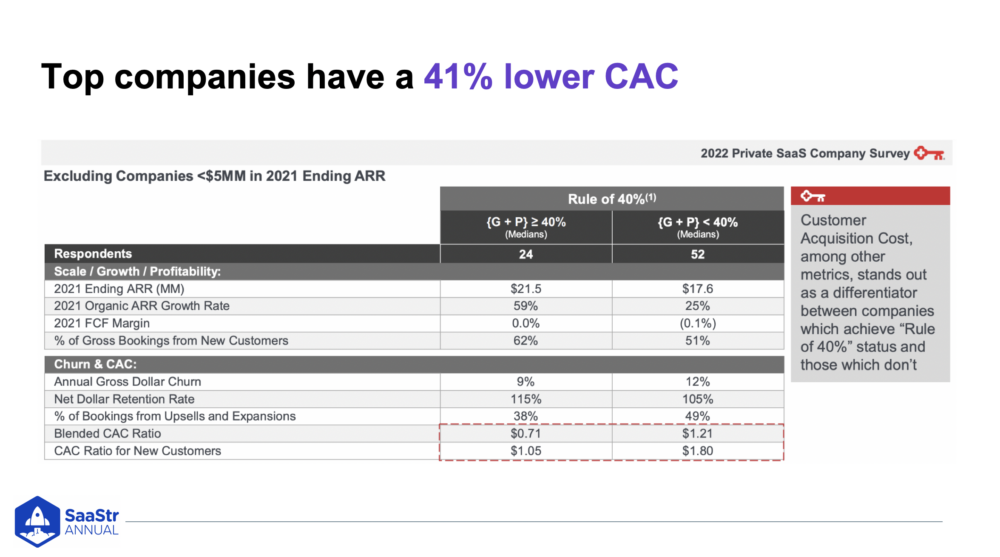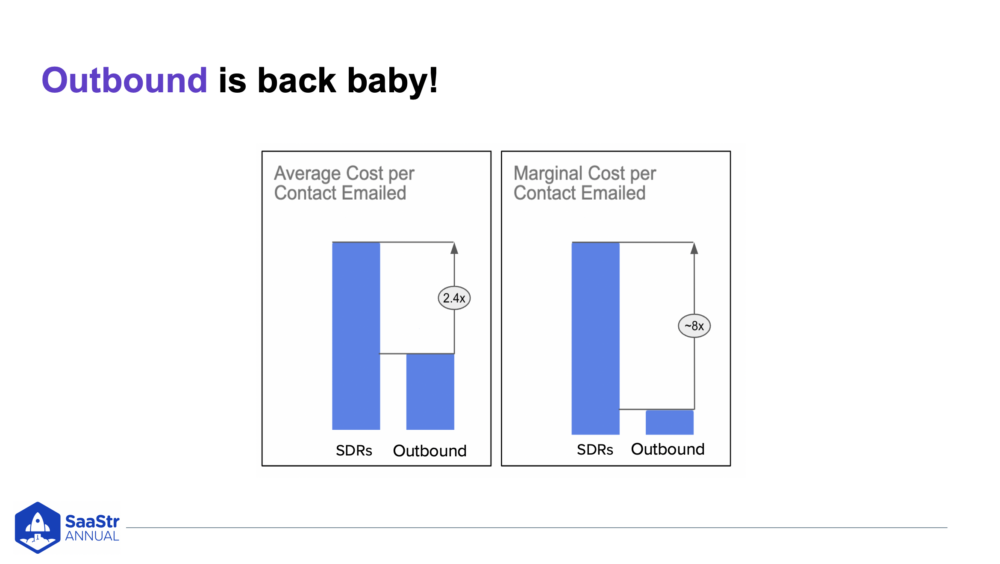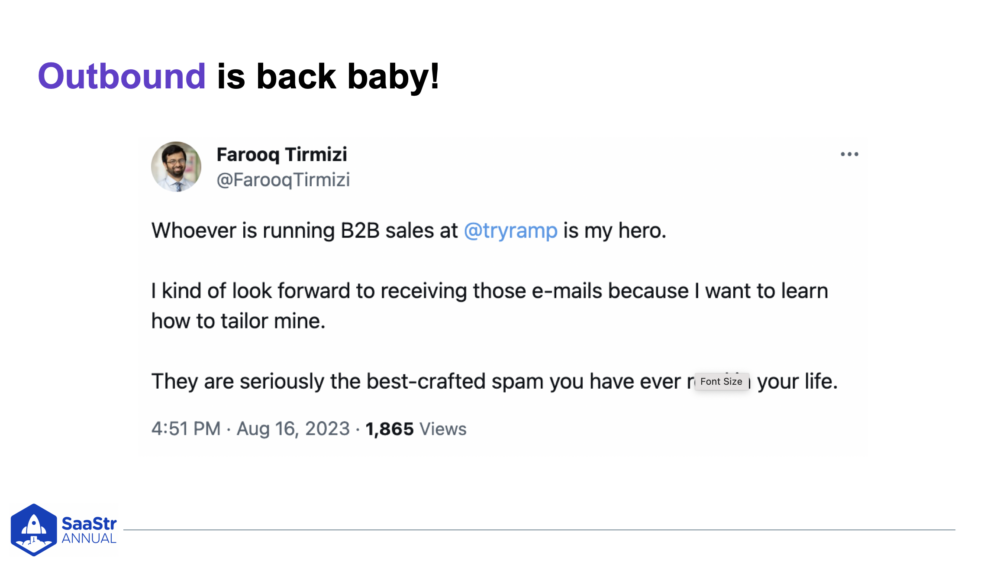In today’s world, there’s a clear shift in what founders, boards, and investors are all after — scalable, low-CAC (customer-acquisition cost) growth strategies.
In a panel, Guillaume Cabane (G) and Martin Gontovnikas (Gonto), co-founders of HyperGrowth Partners, Axelle Heems, Senior Director of Growth Operations at Gorgias, and Morgane Palomares, VP of Marketing at Vercel, share real-life examples of how demand generation, growth, and marketing strategies have been executed to scale beyond 2x ARR each year, even on a low budget.
Let’s deep dive into how combining innovative demand gen strategies with a modern tech stack and specific team setup can provide a winning formula for scaling B2B growth, even with low budgets of greater than a 2x burn multiple.
In this playbook we’ll share:
- Automated outbound at-scale strategies.
- Sales-assisted, product-led growth strategies that close Enterprise leads.
- How to use community as a driver of product-led growth.

For context to kick us off, some of the top SaaS companies have 41% lower CAC than the rest. The data above shows it’s a customer acquisition cost on average of $1.05 vs. $1.80, which is a big difference. So, how do you achieve that? Let’s look at some examples.
Automated Outbound as a Low-CAC Growth Strategy
Axelle Heems, Senior Director of Growth Operations at Gorgias, started us off by walking us through how their demand gen engine is fully automated and optimized using a multi-channel approach to reach all contacts at companies within their TAM. In outbound, they consider three channels:
- Ads
- Customer referral
The first thing they did to automate was use multiple data vendors to gain a clear overview of their entire TAM. From there, strategy comes in. They do a lot of predictive analysis to categorize TAM and prioritize their resources. To get the most efficiencies out of their marketing team and resources, Gorgias puts a big emphasis on using only high-quality data that they audit regularly.
At Gorgias, they focus on an outbound strategy that uses a system of signals or behavioral events gathered from the internet to guide their outreach. For example, if someone in their TAM is hiring for a CX lead, this is a signal for Gorgias to help them figure out a CX motion since their product is a help desk for e-commerce. Another example, for them, would be when a company starts using another tool in the eComm SaaS world, either competitive or complementary to their product.
When they outbounded a prospect with an intent or predictive signal, the dollars per contract average were 3-4x higher than those with no signal.
The entire engine is geared around this and then branches out depending on:
- The high fit of the company
- The awareness stage it’s at with signals
From there it falls into different branches of actions that scale: the first stage is an email sequence, the second stage is ads, the third stage is customer referrals, and so on. Essentially, you invest more into acquiring the customer as they become more aware and have higher intent to buy vs top-loading all your spend in your TAM.

What this chart shows is the difference between the average cost per contact email between the automated Outbound team and the SDR team. So you have a 2.4x difference on the average cost, and then the marginal cost an 8x difference in costs. That’s very important there’s a lot of infrastructure, effort, humans, lots of technology, and lots of data vendors that you’re buying from just to set this all up. However, the benefit is that once it’s up and running, the marginal costs to keep it running are low and it begins to pay for itself. For example, at Gorgias, they were able to send out around a million emails in a quarter, covering each company in their TAM (Total Addressable Market) a couple of times each quarter while keeping costs low.
SDR Outbound vs. Automated Outbound
OK, so let’s say you’re not as sophisticated on automated outbound like a Gorgias or a Ramp? Is it worth switching from manual, human-based outbound to data-driven automated outbound?
Morgane Palomares, VP of Marketing at Vercel joined the company a few years ago, and when she did immediately noticed that every salesperson was hitting or exceeding their quota solely by closing inbound leads. But as they continued to scale and quotas grew, they had to find other ways to hit their revenue targets without relying only on inbound.
First, they built a product advocates team instead of a traditional inbound SDR team. As a developer company selling to developers, they’d hire people out of boot camps to take on this role because they could answer technical questions and know the product better. It worked well and they quickly started moving upmarket to Enterprise and hired 15 outbound SDRs in just six months to help them transition from inbound demand to outbound Enterprise. But, what Morgane found was that their newly minted large team of SDRs didn’t actually know how to go outbound to the developer audience.
So, they began asking themselves whether it would be more effective to pivot to an automated outbound model and began to build one out so that they could send tens of thousands of emails each week and pass anyone responding over to the remaining SDR team. This has allowed them to shrink the size of the team, be more effective, and lower customer acquisition costs.

As Guillaume Cabane, co-founder of HyperGrowth Partners, pointed out, over the past ten years, the outbound channel for emails and calls has been on a downward performance trend because people were desensitized. With the arrival of AI and LLMs, the quality of content is better, so performance and open rates on automated outbound have gone up. In the tweet above, Guillaume found someone saying outbound from Ramp were the best emails ever, and they’re fully automated. No humans involved.
Product-Led Sales As a Low-CAC Growth Strategy
Another low-CAC growth strategy is product-led sales, a trend that Martin Gontovnikas (Gonto), co-founder of HyperGrowth Partners sees gaining popularity. The problem is most companies think self-service and product-led sales (or product-led growth) will be cheap, but most PLGs aren’t really self-service because they need to eventually scale into the Enterprise, which requires an outbound team.
What are some strategies Gonto uses to create a positive product-led sales experience? Let’s discuss an example. First, he copied Morgan’s method above and instead of hiring SDRS, hired product advocates, in this case, junior developers who acted as SDRs. During the onboarding process for a trial, his company used AI to identify which customers might be stuck during the product implementation. They then proactively offered to help, which led to an increase in sales and an improved customer experience.
So we’ve talked about it a lot on saastr.com – but it’s become a huge debate in SaaS, should we switch to PLG?
According to Guillaume Cabane, co-founder of HyperGrowth Partners, “the truth is if you deconstruct why they want it, it’s because they want low CAC and they just mentally build a bridge that. Product-led growth means free sign-ups and free sign-ups is low-CAC, which sounds great. So they just do this PLG thing but then they don’t have the product that goes with it. There’s no virality. There’s no way for the user to get to success on their own. And so there’s no way to build product-led growth.”
So there’s a better way of scaling according to our panelists, which is using product-led sign-ups with separate products to get people engaged and then push that from self-service into a managed sales motion. It’s a much easier transition than like shifting your entire product from an enterprise product down to a self-service in the name of product-led growth, which no one really pulls off.
Morgane Palomares, VP of Marketing at Vercel, shared a relevant example in that their business uses a freemium model to bring in approximately 100,000 sign-ups a month. This approach coupled with allowing users to explore a self-serve demo or talk to sales when they show intent that they’re ready to convert to paid helps them identify interested customers without relying on their SDR team in every situation.
Use Community As a Low-CAC Growth Strategy
When you think about community, you’re probably already dreading the word because you likely think that you have to create your own community from scratch, but in most cases that’s not a good idea. While it makes sense to create your own community when you have something that is free for everybody, or it’s a big portion that is free, or if it’s open source, or if it’s a developer product, but if it’s not that, then you have a closed product. People need to pay. They don’t want to pay to be part of your community. Why should they?
So in those cases, learn to leverage and tap into already existing communities since they’re still relationship-based.
For example, Martin Gontovnikas (Gonto), co-founder of HyperGrowth Partners identified 20 social media influencers in existing communities relevant to their product whom they wanted to talk about them. They researched where they were speaking at events and made sure Gonto was also attending and speaking at those events — not to connect with the audience but to build a relationship with those influencers at speaker dinners. His strategy allowed them to get their content shared more widely, expanding their customer base without investing heavily in advertising or other high-cost marketing techniques.
Other Creative Tactics and Key Takeaways
Another way to scale is through a mutual exchange of perceived value. Gonto’s team wanted more influencers so more people would know the brand. The influencers in this case were developers who had created open-source frameworks and landing pages.
He did three things:
- Offered to redesign those influencers’ websites for free.
- Used the same branding and colors as the product brand so people would see a common theme and make a connection
- In exchange for the free redesign, he added a retargeting pixel on their website so that he could start to run ads against their audiences
He was offering something of perceived high value to them but at a low cost to him.
And the key takeaways from these low CAC growth strategies:
- Get creative and stand out. We’re in a window where AI-generated content, like the example with Ramp mentioned earlier, can drive growth.
- Founders want the low CAC of outbound and a PLG motion. You should start somewhere, but probably not on both sides.
- There’s a strong shift in which tools are currently being used, specifically low code and AI tools for copywriting and automation. If you’re not using this, you’ll be left behind.

